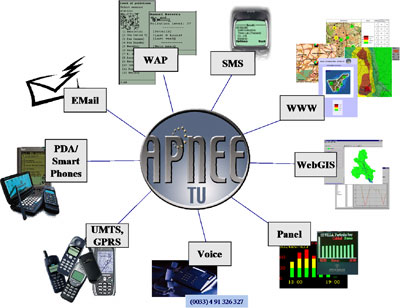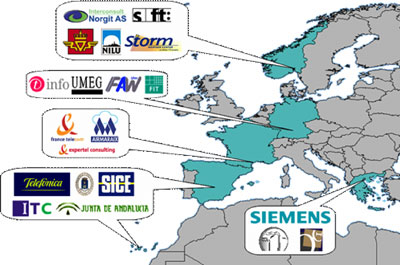
This issue in pdf Subscription Archive: Next issue: July 2005 |
|
|||||||
Air-Quality Information for Multi-Channel Services: On the Air with Mobile Phonesby Gertraud Peinel and Thomas Rose The APNEE project (Air Pollution Network for Early warning and information exchange in Europe) has designed customizable services providing information on air quality for citizens. These services draw on various information channels, including mobile technology, interactive portals for the Internet and street panels. Based on such high-quality dissemination services, even environmental information becomes an attractive product once it is perceived as providing citizens with indicators of their levels of comfort. The APNEE information services are based on the following concepts:
Authorities and scientists have large amounts of data with perfect means of visualization and well-researched models for calculation, forecasts and interpolations. Normally however, citizens are not targeted as potential consumers of these data. Yet citizens are now beginning to call for timely and high-quality environmental information for reasons of comfort and health care, especially when they are individually affected by respiratory diseases. While general information is available via Internet servers and TV video text, some things are still lacking:
To date, most warnings of adverse environmental conditions have made use of broadcast channels. However, radio or TV inevitably reaches a much larger audience than that section of the population actually at risk. National and regional authorities have found it difficult to 'narrowcast' specific environmental warnings or advice only to those living within a specific area. It is this capability that APNEE and APNEE-TU have implemented and tested by utilizing modern IT and telecommunication technology at locations across Europe.
Project APNEE commenced in January 1999 as an RTD project in the Fifth Framework Programme of the European Commission, IST Programme, Key Action I (Systems and Services for the Citizen), Action Line I.5.1. It concluded successfully in December 2001, and a take-up action named APNEE-TU (4/2003 - 3/2004) adapted and tested the APNEE systems at additional user sites in Europe, as well as employing new technologies (eg handhelds, smart phones, PDAs and new mobile protocols like GPRS) for the dissemination of air pollution information. Field trials for the evaluation of these innovations in APNEE and APNEE-TU took place at nine test sites (Oslo, Greenland, Athens, Thessalonica, Marseilles, Canary Islands, Madrid, Andalusia, and the whole of Germany), and the projects included 21 partners from research, government and the IT and telecommunications sectors. The test sites represent a diverse selection in terms of geography, pollution problems and cultural settings. In addition, their experience and development of air monitoring stations were different. We designed and implemented the following 'business collaboration concept', which has proven successful:
APNEE is, first of all, the architecture of a dissemination platform, built around a harmonized environmental database scheme. In this respect, APNEE supports the harmonization of air-quality management systems. This eases the exchange of data (eg among authorities), allows further standardization of methods and directives and simplifies integration into other services and service providers. In addition, APNEE provides a reference implementation of components, required to set up an APNEE infrastructure at a new user site. APNEE is mostly based on royalty-free open-source software that has a very good developer community for support. It can be installed on a standard PC and is easily administrated once the set-up has been completed. The installation and operational costs of APNEE are very low, allowing cities and communities to set up an information portal for air-quality (or any other environment-related) information, even on a low budget. APNEE created a set of reference core modules, including a common database scheme, service triggers, and regional server applications. These core modules are considered to be the heart of the system; however, they may be bypassed or not implemented in cases where only the electronic services are of interest for installation and operational usage, provided that there is a database and a pull-and-push scheme offered via alternative software infrastructures. Thus, the project's e-services pallet currently includes:
These services may be applied individually, in combination, or in parallel with other pre-existing services, where they exist. The complementarity and in particular the context-awareness of services have proven decisive in reaching citizens, that is, in advising people of episodes that might cause harm to their health. MMS services sound attractive from a technology point of view and WAP services allow for more detailed information when on the move. Nevertheless, SMS services have proven sufficient in several field trials. The project was recently presented as a success story among IST projects by Commissioner Viviane Reding during a press conference in Brussels. Future applications of APNEE will be early warning services. We are currently working on risk management concepts and services for cities and urban regions. APNEE was supported by the European Commission DG XIII under the 5th Framework Pro-gramme, IST-1999-11517. Partners included FAW Ulm, Germany (coordinator), Airmaraix, France, Aristotle University Thessaloniki, Greece, Ayuntamiento de Madrid, Spain, Expertel Consulting, France, NILU, Norway, NORGIT AS, Norway, Seksjon for kontroll og overvåking i Grenland, Norway, SICE, Spain, Telefonica I+D, Spain, Universidad Politecnica de Madrid, Spain. APNEE-TU was supported by the EC under contract IST-2001-34154. Additional partners are the Storm Weather Center and National Road Protection Agency, Norway, ITC Canarias and Andalusia Network, Spain, OMPEPT and Siemens, Greece, and UMEG, Fraunhofer FIT (new coordinator), and t-info GmbH, Germany. Links: Greece: Norway: Germany: France: Please contact: |
|||||||



